History Essay: The Battle of the Atlantic and its Impact
VerifiedAdded on 2023/05/27
|8
|2004
|263
Essay
AI Summary
This history essay provides a comprehensive analysis of the Battle of the Atlantic, a pivotal conflict of World War II. The essay begins by outlining the background of the battle, explaining the roles of Germany and the Allied forces, and the strategic importance of controlling the Atlantic Ocean for both sides. It then details the significant events, including the use of U-boats by Germany to sink Allied ships and the Allied responses, such as the implementation of convoys and technological advancements. Furthermore, the essay analyzes the battle through the lens of the Army FM-3 Principles of War, focusing on key principles such as objective, maneuver, unity of command, surprise, and simplicity. The essay concludes by highlighting the impact of the battle and the strategies employed by both sides, emphasizing how the Allied forces eventually gained the upper hand, leading to Germany's surrender and the crucial role the United States played in the war.
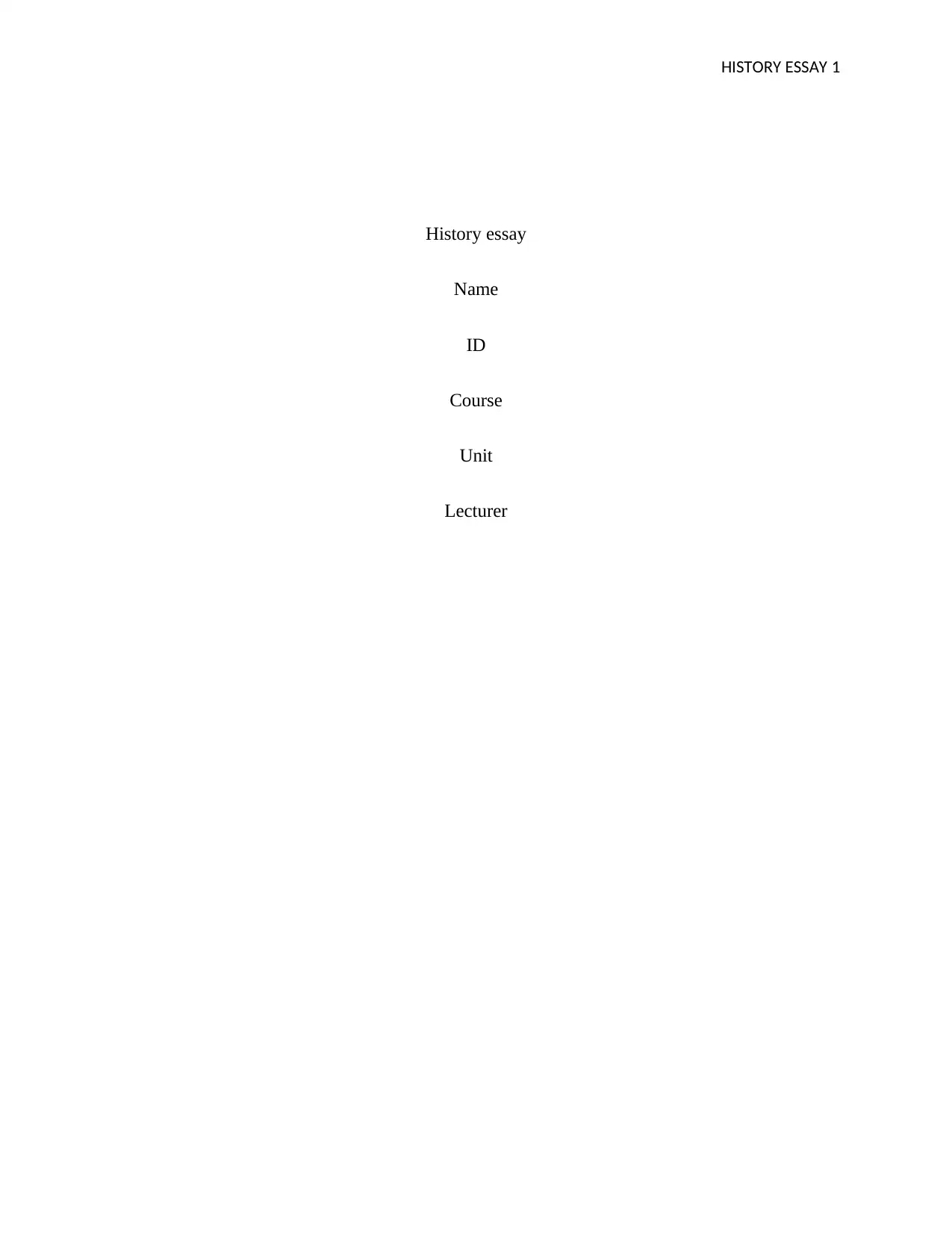
HISTORY ESSAY 1
History essay
Name
ID
Course
Unit
Lecturer
History essay
Name
ID
Course
Unit
Lecturer
Paraphrase This Document
Need a fresh take? Get an instant paraphrase of this document with our AI Paraphraser

HISTORY ESSAY 2
Introduction
The second world war was characterized by various battles. These battles involved single
countries or group of countries. In these struggles, the United States of America took part in
some of them including the battle of Monte Casino, the battle of El Guetta, the battle of Anzio,
the battle of Atlantic among other struggles1. In this assignment, it will elaborate on the battle of
the Atlantic. In elaborating the war, the task will elaborate on the background of the battle, the
significant events of the battle and lastly analyze the battle based on the Army FM-3 Principles
of war.
The battle of the Atlantic
The background of the war.
The Atlantic battle is one of the most extended struggles that the United States of
America took part in the war. The war began in the year 1939 September and went on for six
years ending in May 1945 when Germany surrendered2. The main participants of the battle of
Atlantic were Germany and the Allied forces. The reason behind the emergence of the struggle
was that the two armies, German and the Allied troops were fighting on who to control the
Atlantic Ocean in the year 1939, countries were moving men between Europe and North
America. The Allies wanted to ensure that the flow of men was constant. However, Germany did
not want the trade to proceed. Challenging the process was not easy for Germany, they resolved
1 Barlow & Clarke, (2017) Blue gold: the battle against corporate theft of the world's water.
Routledge.
2 Bennett, (2018) Women and the battle of the Atlantic 1939-45: Contemporary texts,
propaganda, and life writing. In Gender and warfare in the twentieth century. Manchester
University Press.
Introduction
The second world war was characterized by various battles. These battles involved single
countries or group of countries. In these struggles, the United States of America took part in
some of them including the battle of Monte Casino, the battle of El Guetta, the battle of Anzio,
the battle of Atlantic among other struggles1. In this assignment, it will elaborate on the battle of
the Atlantic. In elaborating the war, the task will elaborate on the background of the battle, the
significant events of the battle and lastly analyze the battle based on the Army FM-3 Principles
of war.
The battle of the Atlantic
The background of the war.
The Atlantic battle is one of the most extended struggles that the United States of
America took part in the war. The war began in the year 1939 September and went on for six
years ending in May 1945 when Germany surrendered2. The main participants of the battle of
Atlantic were Germany and the Allied forces. The reason behind the emergence of the struggle
was that the two armies, German and the Allied troops were fighting on who to control the
Atlantic Ocean in the year 1939, countries were moving men between Europe and North
America. The Allies wanted to ensure that the flow of men was constant. However, Germany did
not want the trade to proceed. Challenging the process was not easy for Germany, they resolved
1 Barlow & Clarke, (2017) Blue gold: the battle against corporate theft of the world's water.
Routledge.
2 Bennett, (2018) Women and the battle of the Atlantic 1939-45: Contemporary texts,
propaganda, and life writing. In Gender and warfare in the twentieth century. Manchester
University Press.

HISTORY ESSAY 3
to make use of U-boats to control the Atlantic Ocean. They attacked and sank the ships
belonging to the Allied.
The battle was not easy as it extended to Canada. The German’s U-boats made their way up to
Canada’s doorstep. Canada had to use their navy to defend themselves, showing support to the
Allied powers. Germany’s resolution to sink many ships took away the life of many men. At
some point, the battle did not only take place in the see but also on air and land3; both parties
were keeping watch on their enemies. One of the affected countries that belonged to the Allied
powers is the British. During this war, the British Prime minister Winston Churchill confessed
that what was going to happen on land, sea or air depended on the outcome of the battle. Some
nations were surprised by an attack — for instance, Germany and the British. British made use of
escorts as Germany resolved on using the U-boats4.
Description of the battle
The events in the battle of the Atlantic began when the two powers, the Axies and the
Allied forces, began struggling to control the Atlantic Ocean. The main aim of the Allies to go
for the Atlantic Ocean was to ensure that they resupply Britain together with the Soviet Union
during their disagreement with Italy and Germany. However, the Axies power was a hindrance to
the Allied forces as they did not want the plan to succeed. Many events of the battle were taking
place in the Northern part of Atlantic Ocean. Consequently, the climax of the battle was when
3 Chang, (2014) The rape of Nanking: The forgotten holocaust of World War II. Basic
Books.
4 Perkins, (2017). Preparing for the Fight Tonight: Multi-Domain Battle and Field
to make use of U-boats to control the Atlantic Ocean. They attacked and sank the ships
belonging to the Allied.
The battle was not easy as it extended to Canada. The German’s U-boats made their way up to
Canada’s doorstep. Canada had to use their navy to defend themselves, showing support to the
Allied powers. Germany’s resolution to sink many ships took away the life of many men. At
some point, the battle did not only take place in the see but also on air and land3; both parties
were keeping watch on their enemies. One of the affected countries that belonged to the Allied
powers is the British. During this war, the British Prime minister Winston Churchill confessed
that what was going to happen on land, sea or air depended on the outcome of the battle. Some
nations were surprised by an attack — for instance, Germany and the British. British made use of
escorts as Germany resolved on using the U-boats4.
Description of the battle
The events in the battle of the Atlantic began when the two powers, the Axies and the
Allied forces, began struggling to control the Atlantic Ocean. The main aim of the Allies to go
for the Atlantic Ocean was to ensure that they resupply Britain together with the Soviet Union
during their disagreement with Italy and Germany. However, the Axies power was a hindrance to
the Allied forces as they did not want the plan to succeed. Many events of the battle were taking
place in the Northern part of Atlantic Ocean. Consequently, the climax of the battle was when
3 Chang, (2014) The rape of Nanking: The forgotten holocaust of World War II. Basic
Books.
4 Perkins, (2017). Preparing for the Fight Tonight: Multi-Domain Battle and Field
⊘ This is a preview!⊘
Do you want full access?
Subscribe today to unlock all pages.

Trusted by 1+ million students worldwide
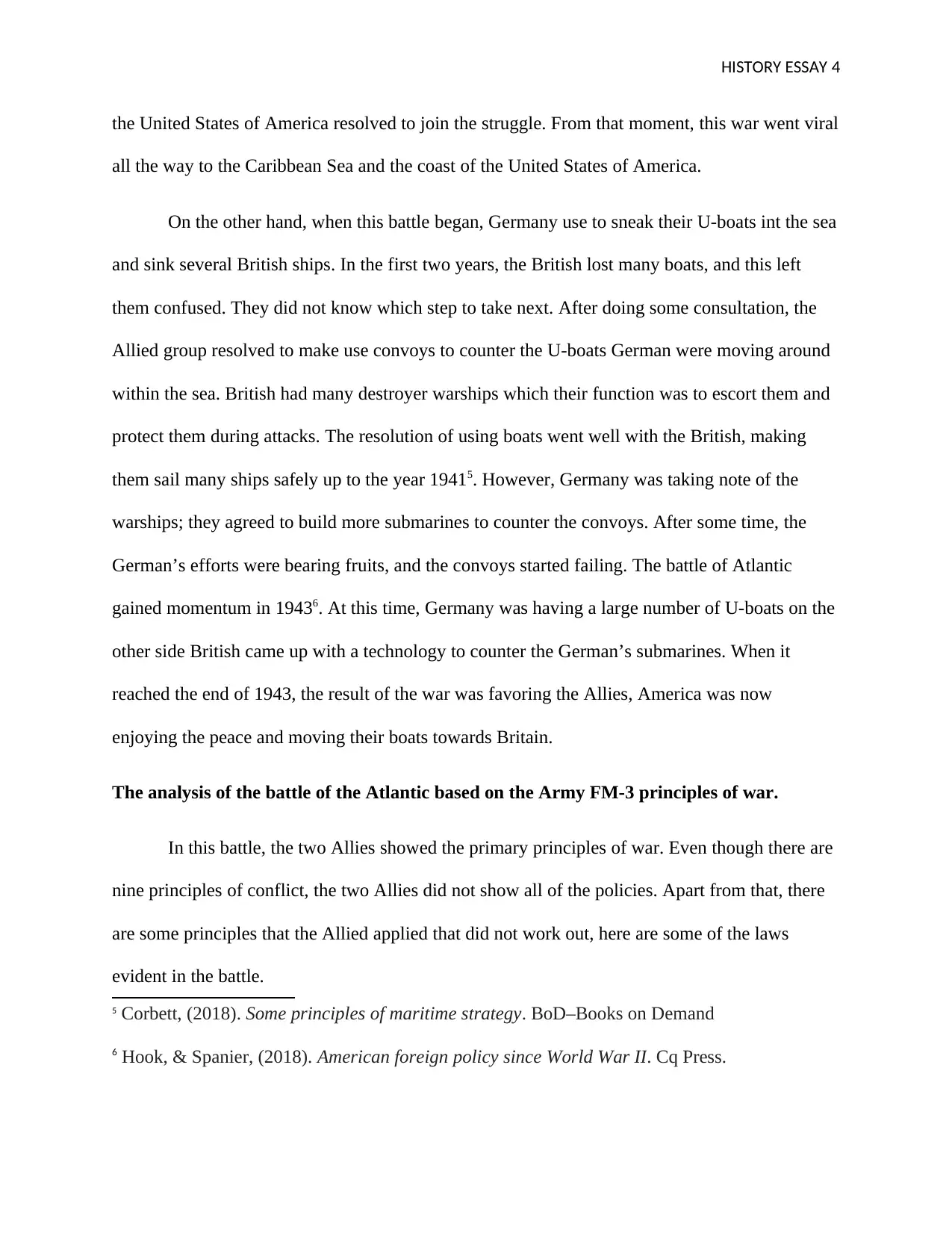
HISTORY ESSAY 4
the United States of America resolved to join the struggle. From that moment, this war went viral
all the way to the Caribbean Sea and the coast of the United States of America.
On the other hand, when this battle began, Germany use to sneak their U-boats int the sea
and sink several British ships. In the first two years, the British lost many boats, and this left
them confused. They did not know which step to take next. After doing some consultation, the
Allied group resolved to make use convoys to counter the U-boats German were moving around
within the sea. British had many destroyer warships which their function was to escort them and
protect them during attacks. The resolution of using boats went well with the British, making
them sail many ships safely up to the year 19415. However, Germany was taking note of the
warships; they agreed to build more submarines to counter the convoys. After some time, the
German’s efforts were bearing fruits, and the convoys started failing. The battle of Atlantic
gained momentum in 19436. At this time, Germany was having a large number of U-boats on the
other side British came up with a technology to counter the German’s submarines. When it
reached the end of 1943, the result of the war was favoring the Allies, America was now
enjoying the peace and moving their boats towards Britain.
The analysis of the battle of the Atlantic based on the Army FM-3 principles of war.
In this battle, the two Allies showed the primary principles of war. Even though there are
nine principles of conflict, the two Allies did not show all of the policies. Apart from that, there
are some principles that the Allied applied that did not work out, here are some of the laws
evident in the battle.
5 Corbett, (2018). Some principles of maritime strategy. BoD–Books on Demand
6 Hook, & Spanier, (2018). American foreign policy since World War II. Cq Press.
the United States of America resolved to join the struggle. From that moment, this war went viral
all the way to the Caribbean Sea and the coast of the United States of America.
On the other hand, when this battle began, Germany use to sneak their U-boats int the sea
and sink several British ships. In the first two years, the British lost many boats, and this left
them confused. They did not know which step to take next. After doing some consultation, the
Allied group resolved to make use convoys to counter the U-boats German were moving around
within the sea. British had many destroyer warships which their function was to escort them and
protect them during attacks. The resolution of using boats went well with the British, making
them sail many ships safely up to the year 19415. However, Germany was taking note of the
warships; they agreed to build more submarines to counter the convoys. After some time, the
German’s efforts were bearing fruits, and the convoys started failing. The battle of Atlantic
gained momentum in 19436. At this time, Germany was having a large number of U-boats on the
other side British came up with a technology to counter the German’s submarines. When it
reached the end of 1943, the result of the war was favoring the Allies, America was now
enjoying the peace and moving their boats towards Britain.
The analysis of the battle of the Atlantic based on the Army FM-3 principles of war.
In this battle, the two Allies showed the primary principles of war. Even though there are
nine principles of conflict, the two Allies did not show all of the policies. Apart from that, there
are some principles that the Allied applied that did not work out, here are some of the laws
evident in the battle.
5 Corbett, (2018). Some principles of maritime strategy. BoD–Books on Demand
6 Hook, & Spanier, (2018). American foreign policy since World War II. Cq Press.
Paraphrase This Document
Need a fresh take? Get an instant paraphrase of this document with our AI Paraphraser
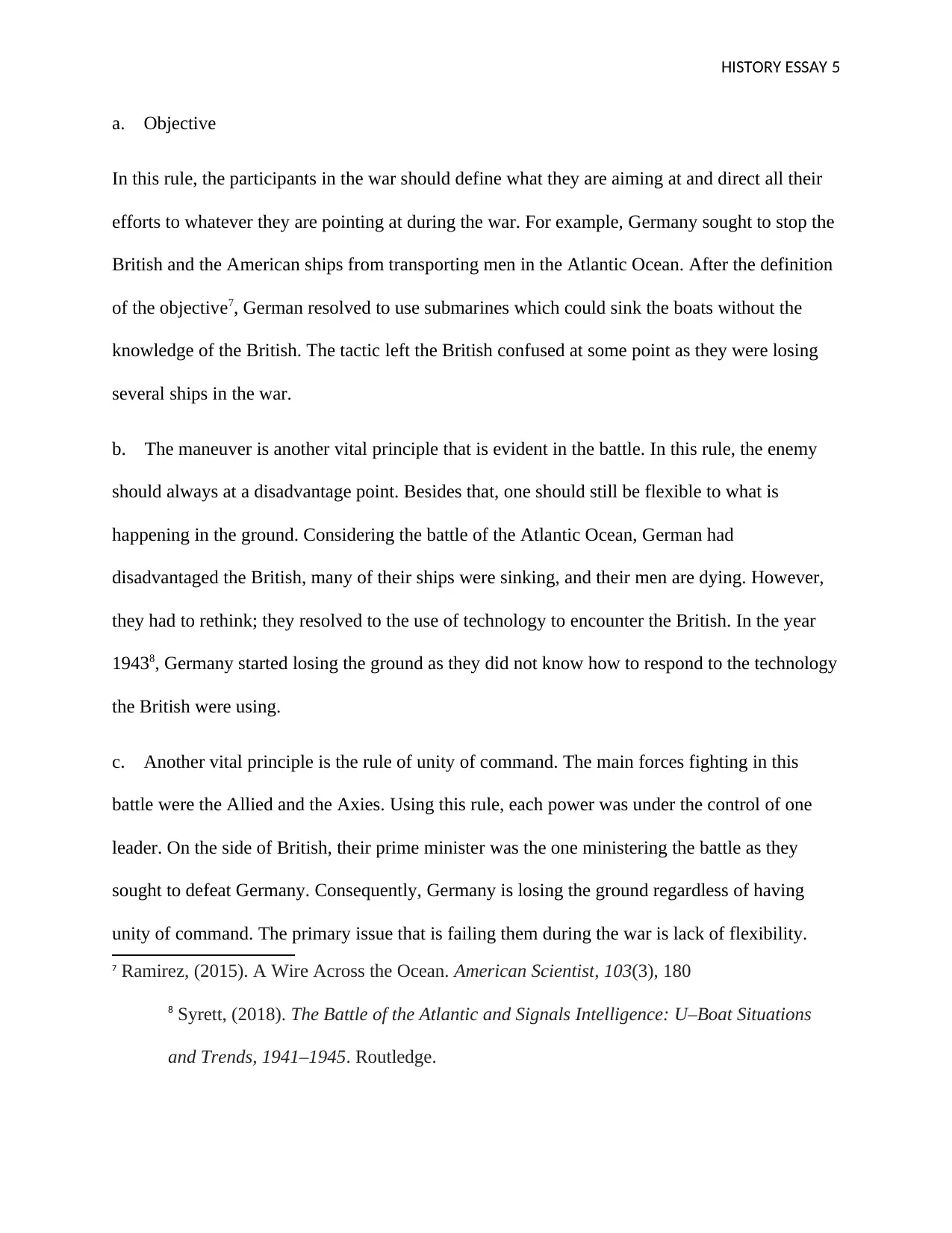
HISTORY ESSAY 5
a. Objective
In this rule, the participants in the war should define what they are aiming at and direct all their
efforts to whatever they are pointing at during the war. For example, Germany sought to stop the
British and the American ships from transporting men in the Atlantic Ocean. After the definition
of the objective7, German resolved to use submarines which could sink the boats without the
knowledge of the British. The tactic left the British confused at some point as they were losing
several ships in the war.
b. The maneuver is another vital principle that is evident in the battle. In this rule, the enemy
should always at a disadvantage point. Besides that, one should still be flexible to what is
happening in the ground. Considering the battle of the Atlantic Ocean, German had
disadvantaged the British, many of their ships were sinking, and their men are dying. However,
they had to rethink; they resolved to the use of technology to encounter the British. In the year
19438, Germany started losing the ground as they did not know how to respond to the technology
the British were using.
c. Another vital principle is the rule of unity of command. The main forces fighting in this
battle were the Allied and the Axies. Using this rule, each power was under the control of one
leader. On the side of British, their prime minister was the one ministering the battle as they
sought to defeat Germany. Consequently, Germany is losing the ground regardless of having
unity of command. The primary issue that is failing them during the war is lack of flexibility.
7 Ramirez, (2015). A Wire Across the Ocean. American Scientist, 103(3), 180
8 Syrett, (2018). The Battle of the Atlantic and Signals Intelligence: U–Boat Situations
and Trends, 1941–1945. Routledge.
a. Objective
In this rule, the participants in the war should define what they are aiming at and direct all their
efforts to whatever they are pointing at during the war. For example, Germany sought to stop the
British and the American ships from transporting men in the Atlantic Ocean. After the definition
of the objective7, German resolved to use submarines which could sink the boats without the
knowledge of the British. The tactic left the British confused at some point as they were losing
several ships in the war.
b. The maneuver is another vital principle that is evident in the battle. In this rule, the enemy
should always at a disadvantage point. Besides that, one should still be flexible to what is
happening in the ground. Considering the battle of the Atlantic Ocean, German had
disadvantaged the British, many of their ships were sinking, and their men are dying. However,
they had to rethink; they resolved to the use of technology to encounter the British. In the year
19438, Germany started losing the ground as they did not know how to respond to the technology
the British were using.
c. Another vital principle is the rule of unity of command. The main forces fighting in this
battle were the Allied and the Axies. Using this rule, each power was under the control of one
leader. On the side of British, their prime minister was the one ministering the battle as they
sought to defeat Germany. Consequently, Germany is losing the ground regardless of having
unity of command. The primary issue that is failing them during the war is lack of flexibility.
7 Ramirez, (2015). A Wire Across the Ocean. American Scientist, 103(3), 180
8 Syrett, (2018). The Battle of the Atlantic and Signals Intelligence: U–Boat Situations
and Trends, 1941–1945. Routledge.
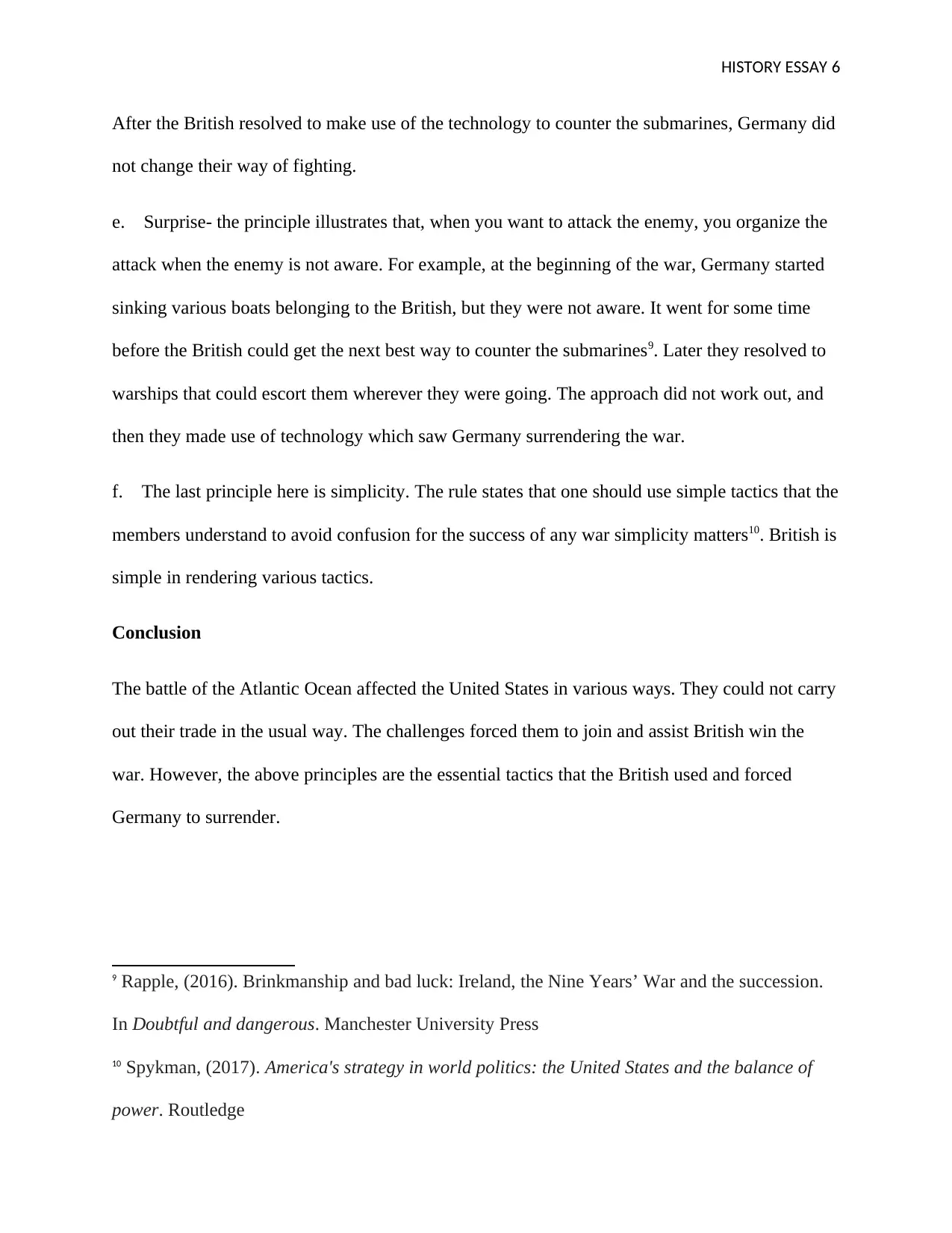
HISTORY ESSAY 6
After the British resolved to make use of the technology to counter the submarines, Germany did
not change their way of fighting.
e. Surprise- the principle illustrates that, when you want to attack the enemy, you organize the
attack when the enemy is not aware. For example, at the beginning of the war, Germany started
sinking various boats belonging to the British, but they were not aware. It went for some time
before the British could get the next best way to counter the submarines9. Later they resolved to
warships that could escort them wherever they were going. The approach did not work out, and
then they made use of technology which saw Germany surrendering the war.
f. The last principle here is simplicity. The rule states that one should use simple tactics that the
members understand to avoid confusion for the success of any war simplicity matters10. British is
simple in rendering various tactics.
Conclusion
The battle of the Atlantic Ocean affected the United States in various ways. They could not carry
out their trade in the usual way. The challenges forced them to join and assist British win the
war. However, the above principles are the essential tactics that the British used and forced
Germany to surrender.
9 Rapple, (2016). Brinkmanship and bad luck: Ireland, the Nine Years’ War and the succession.
In Doubtful and dangerous. Manchester University Press
10 Spykman, (2017). America's strategy in world politics: the United States and the balance of
power. Routledge
After the British resolved to make use of the technology to counter the submarines, Germany did
not change their way of fighting.
e. Surprise- the principle illustrates that, when you want to attack the enemy, you organize the
attack when the enemy is not aware. For example, at the beginning of the war, Germany started
sinking various boats belonging to the British, but they were not aware. It went for some time
before the British could get the next best way to counter the submarines9. Later they resolved to
warships that could escort them wherever they were going. The approach did not work out, and
then they made use of technology which saw Germany surrendering the war.
f. The last principle here is simplicity. The rule states that one should use simple tactics that the
members understand to avoid confusion for the success of any war simplicity matters10. British is
simple in rendering various tactics.
Conclusion
The battle of the Atlantic Ocean affected the United States in various ways. They could not carry
out their trade in the usual way. The challenges forced them to join and assist British win the
war. However, the above principles are the essential tactics that the British used and forced
Germany to surrender.
9 Rapple, (2016). Brinkmanship and bad luck: Ireland, the Nine Years’ War and the succession.
In Doubtful and dangerous. Manchester University Press
10 Spykman, (2017). America's strategy in world politics: the United States and the balance of
power. Routledge
⊘ This is a preview!⊘
Do you want full access?
Subscribe today to unlock all pages.

Trusted by 1+ million students worldwide
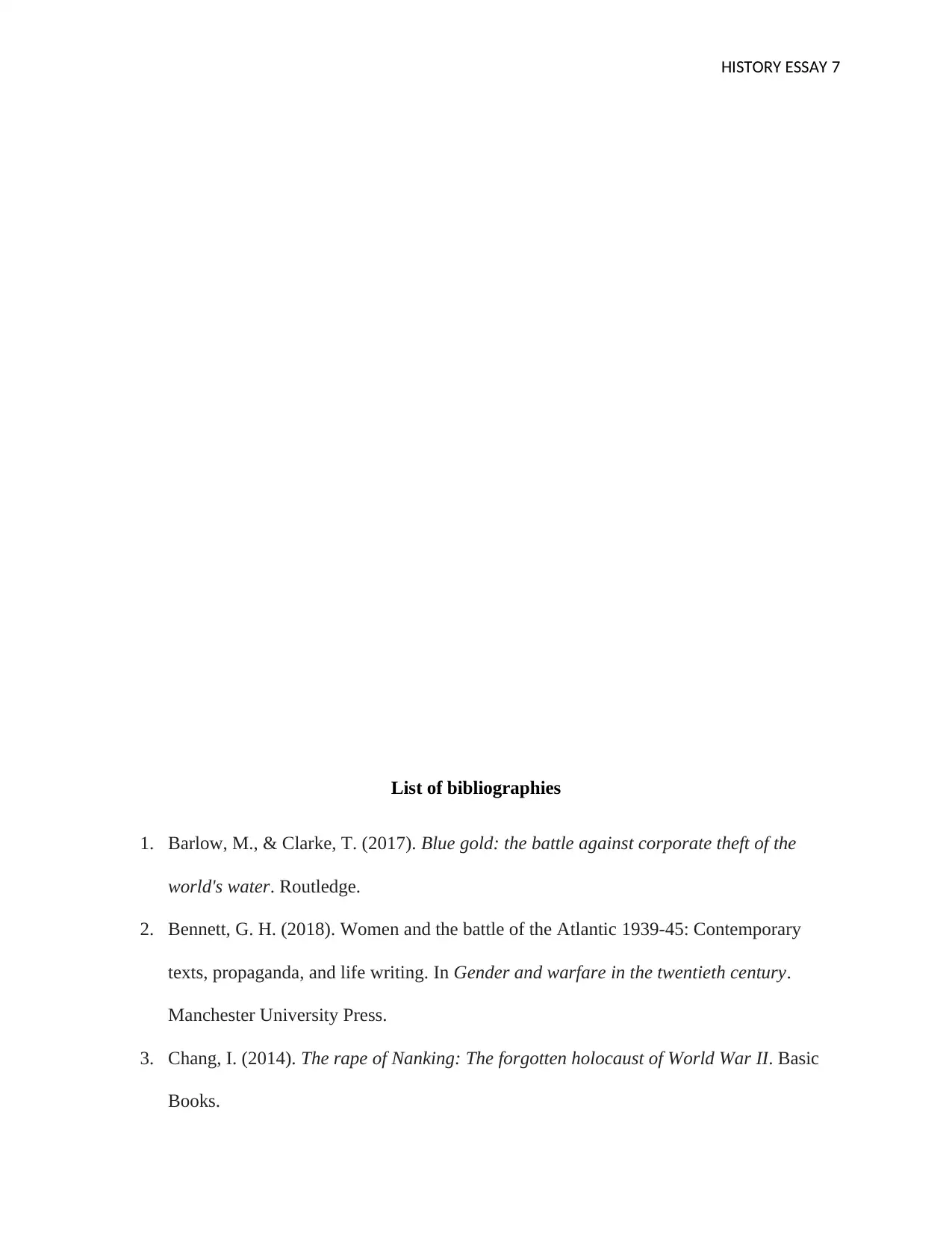
HISTORY ESSAY 7
List of bibliographies
1. Barlow, M., & Clarke, T. (2017). Blue gold: the battle against corporate theft of the
world's water. Routledge.
2. Bennett, G. H. (2018). Women and the battle of the Atlantic 1939-45: Contemporary
texts, propaganda, and life writing. In Gender and warfare in the twentieth century.
Manchester University Press.
3. Chang, I. (2014). The rape of Nanking: The forgotten holocaust of World War II. Basic
Books.
List of bibliographies
1. Barlow, M., & Clarke, T. (2017). Blue gold: the battle against corporate theft of the
world's water. Routledge.
2. Bennett, G. H. (2018). Women and the battle of the Atlantic 1939-45: Contemporary
texts, propaganda, and life writing. In Gender and warfare in the twentieth century.
Manchester University Press.
3. Chang, I. (2014). The rape of Nanking: The forgotten holocaust of World War II. Basic
Books.
Paraphrase This Document
Need a fresh take? Get an instant paraphrase of this document with our AI Paraphraser

HISTORY ESSAY 8
4. Corbett, J. S. (2018). Some principles of maritime strategy. BoD–Books on Demand.
5. Hook, S. W., & Spanier, J. (2018). American foreign policy since World War II. Cq
Press.
6. Perkins, D. G. (2017). Preparing for the Fight Tonight: Multi-Domain Battle and Field
Manual 3-0. Military Review, 97(5), 6.
7. Ramirez, A. (2015). A Wire Across the Ocean. American Scientist, 103(3), 180.
8. Rapple, R. (2016). Brinkmanship and bad luck: Ireland, the Nine Years’ War and the
succession. In Doubtful and dangerous. Manchester University Press.
9. Spykman, N. J. (2017). America's strategy in world politics: the United States and the
balance of power. Routledge.
10. Syrett, D. (2018). The Battle of the Atlantic and Signals Intelligence: U–Boat Situations
and Trends, 1941–1945. Routledge.
4. Corbett, J. S. (2018). Some principles of maritime strategy. BoD–Books on Demand.
5. Hook, S. W., & Spanier, J. (2018). American foreign policy since World War II. Cq
Press.
6. Perkins, D. G. (2017). Preparing for the Fight Tonight: Multi-Domain Battle and Field
Manual 3-0. Military Review, 97(5), 6.
7. Ramirez, A. (2015). A Wire Across the Ocean. American Scientist, 103(3), 180.
8. Rapple, R. (2016). Brinkmanship and bad luck: Ireland, the Nine Years’ War and the
succession. In Doubtful and dangerous. Manchester University Press.
9. Spykman, N. J. (2017). America's strategy in world politics: the United States and the
balance of power. Routledge.
10. Syrett, D. (2018). The Battle of the Atlantic and Signals Intelligence: U–Boat Situations
and Trends, 1941–1945. Routledge.
1 out of 8
Related Documents
Your All-in-One AI-Powered Toolkit for Academic Success.
+13062052269
info@desklib.com
Available 24*7 on WhatsApp / Email
![[object Object]](/_next/static/media/star-bottom.7253800d.svg)
Unlock your academic potential
Copyright © 2020–2025 A2Z Services. All Rights Reserved. Developed and managed by ZUCOL.





